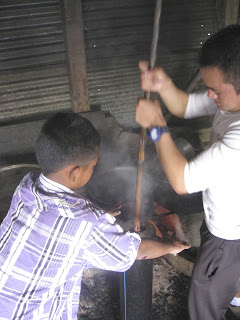In the U.S. church and state are clearly separated by the constitution, it is one one (that’s how they say it in Bhutan) of the founding concepts of this country. The results of this concept being part of our national fabric include a hugely diverse population in the U.S. who freely practice any religion
holidays. Saturday was Lhabab Duechen, The Descending Day of Lord Buddha, an auspicious day indeed on the Buddhist calendar. No classes at school, a class VII outing was organized. The 66 class VII student would be accompanied by 19 upper classmen and any faculty who were interested. We gathered at school at 6:30am for a quick breakfast. Shortly after 7:00am we were hiking. Our destination was Shalipankha, the largest of the local monastic temples or Lhakans, a brisk 2hr uphill climb from school. In the U.S. a group of 85 high school students can easily turn a 2hr hike into a 3 or 4hr fiasco. These kids, in contrast, were excited about the day and boogied, the whole group is at the Lhakan in about two hours. Intentions for the day include a number of community service type of projects as an offering from the students to the monks.
These projects included a lot of the usual cleaning and tidying up around the Lhakan. Some projects stood out in my western perspective. Taking the old prayer flag remnants off the fallen flag poles so that new flags could be tied on and the poles erected at some point. Cleaning the dozen tin cans which had been emptied of mushrooms for shamu datse, each can was filled with good soil, orchids were collected from the forest, and the cans were arranged on the front steps of the Lhakan.
For the most part the students hiked up in casual athletic clothes we might call sweats, they say track. Each with a day pack on their back. During the day sometime all the students changed into kira and gho, the national dress, so they could visit the temple and participate in prayer. I always think the students look rather formal and yet festive at the same time when they wear kira and gho of their own choice instead of the school uniforms I see them in every day. At
one point on the hike the route tops out on a ridge and from that vantage one can look out over two different valleys. Scattered in each are single rural houses and the small clusters of houses that are called villages. In each vista, one north and one south, one could pick out a half dozen Lhakans attesting to how tightly Buddhism is woven into the fabric of every community in Bhutan. In addition to the temples the rural countryside is thoroughly populated with Choetens, Mani Dangrim, prayer flags on poles, and Darshing, walls like choetens. When I happen across one of these when I am wandering about it always feels like a special occasion. Many of the prayer walls and choetens have roofs made from natural stone, very often it looks like they have been in existence since the stones were formed geological eons ago. Every time I see one I take a picture, I am simply enraptured by these ancient roofs which look to be as old as the mountains upon which they sit. As with all Buddhist structures one always walks around in a clockwise direction so that your right hand is closest to the choeten or whatever. If there are prayer wheels use the right hand to give them a turn.
One group of older students worked over open fires all morning preparing tea and then five dishes
for lunch. Feeding 85 people is quite a task when everything is prepared from scratch and the cooktop resembles a bonfire. First item on the menu was suja, butter tea. The leaves for this brew are from a variety of mistletoe, or so I’ve been told. The dried leaves are boiled for some time and then butter is added by the pound. The traditional method involves pouring a portion of the hot tea into a tall container, adding the butter and vigorously working a plunger to thoroughly mix in the melted butter so it won’t separate and float on top, homogenization by brute force. Midmorning the students are served suja and sliced bread, both considered a special treat. The lunch menu includes the primary necessity, rice, a nice ezay which is a condiment like salsa, of fresh cabbage, chana or chickpeas, emma datse which is chilies and cheese, shamu and kewa datse which is mushrooms and potatoes with cheese, and dhal or lentil soup. The students are excited by the variety, something which is nonexistent in their daily fair at school, their plates are full and by the time second share is finished every pot is
empty. Empty serving containers are always kudos for the cooking crew.
The afternoon was a bit more relaxed, planting flowers, relaxing, playing a few games, visiting the temple. The original temple at this site was replaced a few years ago. The interior still smells of the cypress wood of which the floors, stairs and railings are built. The harvesting of cypress trees is tightly regulated in an effort to preserve the rapidly diminishing number of cypress trees in Bhutan. Around 4:00 the students assembled for prayer. Tea is served and then we all head back to school in the same random fashion in which we arrived. Shortly before dark almost everyone is back at school. It has been an auspiciously successful auspicious day.





canadian thanksgiving traditions
ReplyDeletecanadian thanksgiving food
canadian thanksgiving 2017
canadian thanksgiving vs american thanksgiving
thanksgiving canada
thanksgiving day canada 2017
canadian thanksgiving 2018
canadian thanksgiving 2016
What is the story behind Canadian Thanksgiving?
bhai dooj messages hindi
ReplyDeletehappy bhai dooj images
happy bhai dooj gif
happy bhai dooj quotes
happy bhai dooj images in hindi
bhai dooj wishes for brother
bhai dooj shayari
happy bhai dooj status